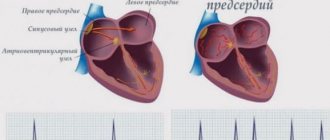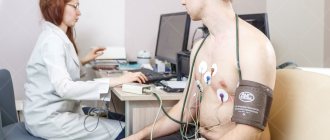Atrial fibrillation is a common heart rhythm disorder. If the heart functions normally, with each beat there is a sequential contraction of its parts. With atrial fibrillation, the two atria lose the ability to contract harmoniously and do not so much beat as twitch randomly - “flicker”.
As a result of this disorder, blood flow slows down, which leads to the accumulation of blood and the formation of blood clots. Blood clots, once in the blood vessels of the brain, interfere with the blood supply to the brain, causing a stroke, which can be fatal.
Article navigation:
symptoms / causes of occurrence / technologies for determining arrhythmia / tonometers for diagnosing atrial fibrillation
Read in this article:
- What is atrial fibrillation?
- Why is the heart rhythm disrupted?
- Symptoms of atrial fibrillation
- Detection of arrhythmia using a tonometer
- Tonometer with ECG function
- What to do if the device shows arrhythmia?
- Advantages of a tonometer measuring atrial fibrillation
Doctors recommend regularly measuring blood pressure, even if a person is not bothered by problems with the heart and blood vessels. But such monitoring is especially important for those who have a predisposition to cardiovascular pathologies or have been diagnosed with diseases of this nature. This allows you to detect the development of the disease at the earliest stage, prevent complications and take the necessary measures in time.
How to choose a tonometer: practical tips
Home — For the public
- Map of medical organizations
- Vaccination
- Clinical examination
- Fluorography
- Addresses and opening hours of clinics
- Emergency rooms
- Oncology
- Where to take an HIV test
- Healthy child's office
- Services
- Prevention of CVD
- Disease Prevention
- World Patient Safety Day
- Newspaper "Medical News"
- specialist
- School of Health
— Disease prevention
- HIV infection
- All about vaccination
- All about proper nutrition
- Hepatitis
- Flu
- Dementia
- Schoolchildren's health
- STD
- Tick-borne encephalitis
- Whooping cough
- Measles
- Legionellosis
- Meningococcal infection
- Oncology
- Acute intestinal infection
- Pediculosis
- First aid
- Pneumococcal infection
- Pneumonia
- Prevention of rabies
- Dependency Prevention
- Rotavirus infection
- Diabetes
- Cardiovascular diseases
- Injuries
- Tuberculosis
- Tularemia
- Physical activity
- Obstructive pulmonary disease
- Exotic infections
- Ecology
- Why is swimming in ponds dangerous?
— Cardiovascular diseases — Practical advice on measuring pressure and choosing a tonometer
THE ONLY WAY TO FIND OUT YOUR BLOOD PRESSURE IS TO MEASURE IT WITH A MODERN TONOMETER.
REGULAR MONITORING OF BLOOD PRESSURE (BP) IS A VITAL NECESSITY!
Doctors all over the world attach great importance to the patient’s self-regular measurement of blood pressure.
"GOLD STANDARD"
- have a blood pressure meter (tonometer) at home, which allows you to systematically monitor blood pressure levels and gives you and your doctor confidence that the prescribed treatment is effective.
HOW TO CHOOSE THE RIGHT TONOMETER?
According to the latest medical research, it is most optimal to measure blood pressure using an automatic electronic blood pressure monitor. The user just needs to fix the cuff and press the button, the tonometer will do the rest.
In pharmacies you will find different brands of electronic tonometers
Trust control over your blood pressure levels only to reliable professional equipment.
THE BEST TONOMETERS THAT YOU CAN TRUST ARE TONOMETERS THAT HAVE PASSED CLINICAL APPROBATION (an expert opinion from doctors based on a carefully conducted and statically reliable test of the equipment on a group of patients of different ages and genders with different health conditions).
The World Hypertension League recommends regularly measuring your blood pressure with clinically proven blood pressure monitors!
EVERY OMRON TONOMETER IS CLINICALLY TESTED.
HOW TO CORRECTLY MEASURE BLOOD PRESSURE?
It is necessary to measure blood pressure twice a day: in the morning, immediately after waking up, and in the evening, in a quiet, calm environment, 30 minutes after physical activity, or taking food or medication. You cannot talk or move during the measurement. The measurement is taken in a sitting position. The hand should rest completely on the table, the back should be supported. The cuff should fit the circumference of the arm and be positioned at heart level.
CORRECT SELECTION OF THE CUFF IS AN IMPORTANT CONDITION FOR THE QUALITY AND ACCURACY OF BP MEASUREMENT.
The patented OMRON fan-shaped cuff, which has no analogues among other manufacturers, allows for the conical shape of the hand to be taken into account. This ensures uniform pressure distribution over the entire area of the artery located under the cuff, thereby ensuring the most accurate measurement. The length of the inner chamber of the cuff should cover 80% of the circumference of the arm.
OMRON cuffs:
Average
cuff, arm circumference 22-32 cm
Big
cuff, arm circumference 32-42 cm
Children's
cuff, arm circumference 17-22 cm
Universal cuff
, arm circumference 22-42 cm, (suitable for most users with medium to full hands). A universal cuff is a good choice if several family members use the tonometer at once.
ONLY OMRON TOUCH METERS WORLDWIDE USE Intellisense INTELLIGENT MEASUREMENT TECHNOLOGY.
Intellisense technology controls the measurement process like a doctor, listening to the pulse, which eliminates excessive compression and re-inflation, ensures optimal pressure in the cuff with each measurement, and as a result, obtains the most accurate result. The Intellisense algorithm allows you to accurately measure blood pressure in case of arrhythmia, pressure surges and weak pulse filling.
Double measurement with a single inflation of the cuff in OMRON tonometers:
The first measurement
is made immediately
during the cuff inflation process: the device adapts to the patient and inflates 20-30 mm above his systolic blood pressure
The second measurement
is performed as standard
when deflating the cuff.
WARRANTY FOR OMRON TONOMETERS IS 5 YEARS.
MAINTENANCE OF THE EQUIPMENT IS CARRIED OUT FREE OF CHARGE DURING THE ENTIRE SERVICE LIFE OF THE DEVICE IN OMRON SERVICE CENTERS.
CERTIFIED REGIONAL SERVICE CENTER
for servicing OMRON Healthcare products (Japan)
Ekaterinburg, st. 8 Marta, no. 5, office 117, tel/fax (343) 371-30-84,
E-mail, www.csmedica.ru
Free hotline in Russia: 8-800-55-00-80
An excellent choice is the easy-to-use new automatic blood pressure monitor OMRON M2 Basic with a shoulder cuff, with memory for 30 measurements and an adapter included, which has everything you need for self-monitoring your pulse and blood pressure at home.
M2 Basic (HEM-7121-ALRU) Registration certificate No. РЗН 2015/3210 dated 10/16/2015
Before use, read the instructions and consult a specialist.
What is atrial fibrillation?
One of the most common cardiac pathologies is atrial fibrillation. The human heart consists of four chambers that contract synchronously: first the atria, then the ventricles. But for various reasons, a malfunction may occur, as a result of which the ventricles continue to contract as usual, but the atria do so at an increased frequency.
In this situation, synchrony is disrupted, part of the blood is not ejected from the ventricles into the systemic and pulmonary circulation, the aorta and artery are not completely filled with blood. As a result, there is a risk of stagnation, and this is fraught with the formation of blood clots. This condition is very dangerous, since the resulting blood clots can get stuck in the arteries and cause a heart attack, stroke, intestinal peritonitis, and gangrene of the extremities.
Why is the heart rhythm disrupted?
Quite often it is not possible to identify the exact causes of the development of atrial fibrillation. However, there are several factors that are most likely to cause such disturbances in the functioning of the heart:
- Abuse of alcohol, tobacco;
- Severe emotional stress, stress;
- Hyperthermia, electric shock;
- Obesity, a large amount of excess weight;
- Genetic predisposition, heredity.
Symptoms of atrial fibrillation often appear against the background of other diseases, mainly cardiac: myocarditis and hypertension, ischemia and cardiosclerosis, heart failure and heart defects, both congenital and acquired. The cause of arrhythmia may be a congenital pathology of the heart valve or serious diseases of the thyroid gland, lungs, and kidneys.
Symptoms of atrial fibrillation
Regular failures in the contraction of the ventricles and atria negatively affect the heart muscle and its functions. Recognizing the pathology can be quite difficult due to the similarity of the symptoms of atrial fibrillation with the influence of other factors:
- An accelerated heartbeat is felt;
- Attacks of shortness of breath appear;
- Suddenly your head starts to feel dizzy and hurt;
- There is a feeling of pressing pain in the chest;
- It feels like your heart is beating faster than usual;
- Possible loss of consciousness.
Obviously, such manifestations can be attributed to the body’s reaction to stress, fatigue, and physical activity.
Alarming symptoms should be considered increased headaches, tremors of the limbs, insomnia, as well as regular signs of panic. When the heart rhythm is disturbed, muscle weakness often appears, which interferes with usual physical activity, and sweating is activated.
With atrial fibrillation, the pulse may increase, and then increased sweating, anxiety, and tremors of the limbs appear. In some cases, the heart rate decreases. If its value is less than 60 beats per minute, the brain does not have enough oxygen, hence pre-syncope, loss or clouding of consciousness.
If the pulse remains normal, heart rhythm disturbances usually occur asymptomatically. This is especially dangerous because the person does not even know about the development of the pathology, does not seek medical help and does not have the opportunity to prevent dangerous consequences.
How to measure blood pressure correctly
In addition to the quality of the tonometer itself, some other factors also influence the accuracy of the measurements. To get the most accurate results, try to follow these rules:
- Measure your blood pressure at rest, not after exercise or stress. Immediately before the manipulation, sit quietly for a few minutes and try to completely relax.
- The mobile phone should be put away.
- Carry out the manipulation in a sitting position, maximum - lying down if the person cannot sit due to poor health.
- Avoid drinking caffeinated drinks at least one hour before your procedure.
- Empty your bladder first.
- Take the most comfortable and relaxed position; the cuff should not squeeze your arm or, conversely, dangle freely. At the same time, it is advisable not to slouch and not talk.
- About 1.5 hours should pass after eating.
- Do not smoke! It would be better at all, but at least an hour before the procedure - for sure.
- The measurement area should be at heart level. When using a shoulder tonometer, the left hand rests on the table in a calm state, the wrist one is bent at the elbow and supported by the right hand.
- Feet should be flat on the floor. Don't cross them or sit cross-legged.
pixabay.com/cdz
Detection of arrhythmia using a tonometer
The main way to diagnose arrhythmia is an ECG. However, such examination does not always reveal disorders if they appear only from time to time. In addition, routine examinations are carried out at a certain interval, during which pathology can actively develop.
The simplest and most affordable option for monitoring heart rate is to use a tonometer with an arrhythmia indicator. For example, in the Beurer line of pressure measuring instruments, all models are equipped with this function. During the procedure, the device analyzes the rhythm of heart contractions and displays the corresponding icon if the indicator differs from the norm.
The automatic blood pressure monitor detects even small air fluctuations in the cuff chamber. Such differences in air pressure are associated with blood flow in the compressed artery. The oscillations are analyzed, converted into electronic signals and displayed on the screen in the form of symbols or numbers. At the same time, the device records the heart rate. A change in heart rate may also indicate the development of arrhythmia.
Tonometer with ECG function
There are also blood pressure monitors that measure atrial fibrillation. This is how the Beurer BM 95 device works, which is used not only to determine blood pressure, but also to record an ECG.
During measurements using an electrocardiograph, messages may appear on the screen about:
- Reduced heart rate (bradycardia);
- Increased heart rate (tachycardia);
- Pauses in the cardiac cycle that last more than 2 seconds;
- Heart rhythm disturbances, including due to atrial fibrillation;
- Changes in the shape of curves when recording an ECG due to arrhythmia.
When measuring blood pressure, the device calculates the average heart rate and also compares blood pressure values with the norm established by WHO. The results of this comparison are displayed on a color scale for clarity.
If you have a tendency to arrhythmia, for example, a hereditary predisposition, you should use just such a device. Timely detection of arrhythmia will allow you to take the necessary measures and prevent complications. The same applies to people who have already been diagnosed with heart rhythm disturbances. If you have a tonometer with this function at home, it becomes possible to monitor your heart function at home.
In addition, the Beurer BM 95 can be connected to the CardioExpert application, and then all data will be transferred to a smartphone or computer. This will help the doctor to clearly see the dynamics of the changes taking place, select the necessary diagnostic techniques, and evaluate the effectiveness of the current treatment.
Causes
Factors leading to atrial fibrillation can be divided into two main groups:
Cardiac (heart)
Extracardiac (not cardiac)
- hypertension
- cardiac ischemia
- heart failure
- coronary artery disease
- congenital heart defects
- heart valve defects
- myocarditis
- pericarditis
- heart tumor
- consequences of heart surgery
- chronic obstructive pulmonary disease
- chronic kidney disease
- thyroid diseases
- sleep apnea
- electric shock
- viral infections
- diabetes
- chronic alcoholism
- obesity
- stress
With atrial fibrillation, as a result of a malfunction of the heart, clots (thrombi) can form in the atria, which travel through the bloodstream to the brain and lead to a stroke.
Early detection of atrial fibrillation can reduce the risk of stroke .
What to do if the device shows arrhythmia?
When using a conventional automatic blood pressure monitor with an arrhythmia detection function, it is important to know which icon on the screen indicates an abnormal heart rhythm. This information is in the instructions.
If such a symbol appears on the display following the measurement results, you need to repeat the procedure after 7-10 minutes. During this period, you cannot engage in vigorous activity; it is best to just sit quietly. If the symbol reappears or if arrhythmia is regularly indicated, you should consult a doctor.
It is important to remember that readings from a home blood pressure monitor cannot serve as a basis for making a diagnosis. If the device indicates an irregular heart rhythm, this is an indication for consultation with a cardiologist and an examination, on the basis of which the doctor will draw conclusions.
It should also be remembered that the tonometer can show arrhythmia if a person talks or moves during measurements, takes it after consuming tonic products, or in a state of stress or nervous overexcitation.
Arrhythmia detection technologies
Some models of automatic blood pressure monitors are equipped with technologies for recognizing atrial fibrillation. As a rule, the essence of such technologies is to measure pressure using two methods - oscillometric and auscultatory (Korotkoff method).
Afib is a patented stroke risk detection technology developed by Microlife . Afib allows screening for atrial fibrillation during blood pressure measurement, which significantly increases the chances of early detection of the disease.
Duo Sensor technology Tensoval automatic blood pressure monitors . The main measurement mode is the Korotkoff method, but if the sonority of the heart sounds is very weak (which are not captured by the Korotkoff method), the oscillometric method is activated.
Nissei 's Twin Check technology also uses two measurement methods. The arrhythmia indicator icon indicates the presence of an irregular pulse.





